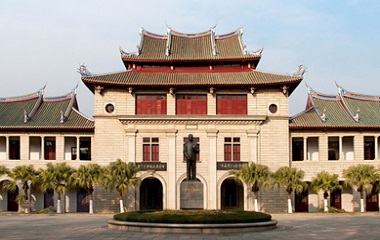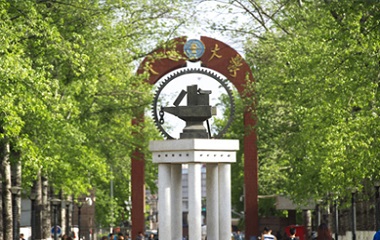[Laos] Duangpaserth Vilakhone, Chengdu Textile College

When I was a child, my family lived in a small village in Luang Namtha, Laos. There was a small river in front of the village, which flew quietly. There was also a small bridge made of several long planks running across both sides, connecting the village and the outside world. It would creak and stagger as people walked on it. But at that time, it was my paradise there. Every summer, my friends in the village and I would spend the whole day in the river, catching fish, swimming and playing water fights. We are so happy that we often forgot to go home.
One day, my father pointed to the small bridge in front of the door and said, “There is a super big country across the river called China. When you have the opportunity, you must cross this bridge and go to China to seek your own dream!” It was the first time I knew the name “China”. Since then, my father’s words have taken root and buried a deep longing in my heart.
People often say, “Always remember, and there will be echoes!” After graduating from high school, I really went to China to study construction engineering. My first stop was Chengdu, the land of abundance. Chengdu is a flat and vibrant city.
Although it is humid and cold in winter compared with Laos, there are hotpot and Sichuan Opera in Chengdu, which is full of the taste of life. There are also many enthusiastic Chinese friends. Even when I was not proficient in Chinese, I never worried about getting lost in the street. Bicycles are everywhere here, like in a kingdom of bicycles, making it very convenient to travel. China is certainly large. Even Chengdu alone has more scenery than I can see even if the rest of my life were spent in traveling.
But don’t worry! The high-speed railway can solve your problem! During my four years in China, I rode the high-speed railway and enjoyed the wonderful rivers and mountains of China, which inspired boundless passion in my heart. What most unforgettable is all kinds of bridges that I saw. Every place impressed me deeply. In my friends’ words, I was like Grandma Liu entering the Grand View Garden and everything seemed fresh to me! In Jiangsu, I saw small and elegant ancient stone bridges, lying quietly on the surface of the garden lake.
They are all made of stone, carved with various exquisite patterns on the stone fences. The lotus flowers in the water were fully blooming, the fish were playing under the lotus leaves, and the pavilions were reflected on the lake, which were all beautiful. In Hubei, I saw the Wuhan Yangtze River Bridge, which is both for highway and railway. The magnificent bridge flies across both sides, on which cars and pedestrians were in constant flow, and under which the train was roaring under your feet.
It is magical enough just to think about it. In Chongqing, I saw all kinds of overpasses in the city, intertwined like ribbons, making people dazzle. In Guizhou, I also saw viaducts connecting viaducts, some like rainbows, some like sailboats, and some like lighthouses, decorated with various colors such as orange, bright red, silver and white, etc., stretching over rivers and ridges, dotting the green mountains and waters, and making themselves beautiful scenery.

We have to admire the superb skills of Chinese architecture and the strength of the country. You know, China’s road and bridge projects have the first place in the world. Every time I saw a bridge, I would have a better understanding of architecture and my imagination would also become richer.
There are many moving poems about bridges in ancient Chinese poetry, such as the sad lines: “It’s sad to see the spring water flowing green under the bridge, in which her stunning beauty was once reflected;” the aesthetic lines: “Two waters hold a mirror-like lake, two bridges fall like rainbows;” and the romantic lines: “On the twenty-fourth bridge on the moon-lit night, where are the beauties who played the flute?”
This is China’s bridge, blended with antiquity and modernity, mixed with nature and humanism, and permeated with unique beauty and vibrant atmosphere. For the Chinese, the bridge is not only a convenient building for people to pass through, but each has its moving story. The beauty of Chinese bridges was the source and motivation for me to explore the depths of the Chinese language and Chinese culture.
I made my mind to study hard and bring advanced technology back to my home country to benefit more people. Chinese culture is broad and profound. Although my major courses were very fully scheduled, I would still try to find time to learn Chinese.
I took many optional courses in traditional Chinese culture: traditional Chinese painting, calligraphy, seal cutting and so on. I also took part in the school’s recitation competition. It was so cool when I recited Cao Cao’s “A Short-Song Ballad” with emotion accompanied by music in my own national costume.
In the four years when I was China, I broadened my horizon. Every day here was busy and fulfilled. Sometimes at night I would be homesick and miss the small village of Luang Namtha. At such moment, my hometown bridge would appear on top of the Chinese bridges, warm and remote. But I knew that I still had a lot of things to do, and had to work hard and persevere. Then dream would come back in my happy sleep again.
After COVID-19 broke out during the Spring Festival in 2020, I returned to Laos. I am very regretful that I wasn’t able to take graduation photos with my teachers and classmates because of the epidemic, but my experience of studying in China has benefited me a lot and my work experience there has also boosted my confidence.
Now I work in the Boten Special Economic Zone in Laos, which is a hot land on the China-Indochina Peninsula Economic Corridor of the “Belt and Road Initiative” adjacent to Xishuangbanna in Yunnan, China. Here, there are many engineers and technicians from China. Because I know both Lao and Chinese, I soon became a “celebrity” between my colleagues in China and Laos.
Together, we are skillfully merging Chinese and Lao culture into the long river of Boten’s development with the language of architecture and industrious sweat. Now bridges have sprung up in Laos. The small wooden bridge in front of the village is still there, but I know that it will change in the near future.
It has been almost two years since I returned to Laos, and I am still full of nostalgia for my studying experience in China. I feel very lucky that I have spent a period of youth in this beautiful country. Regardless of the lapse of time, as a Laotian who has studied in China, I will always be grateful to China and to the Chinese people who have helped and supported me.

Looking back on the dribs and drabs in China, those beautiful scenes are still fresh in my mind. The current international situation is ever-changing, and, China, particularly after the outbreak of the epidemic, has been heckled by the leaders of Western countries led by the United States. But I always believe that the warm and kind-hearted Chinese people and the extremely responsible Chinese government will always be the light and hope of the world.
I once saw a Chinese movie called The Ferryman, in which the ferryman is a superhero of the city, who rescues people from their pain and resists the sadness of the world with love and warmth. I think this ferryman is very much like the image of China in my heart: use his own strength, dedicate himself to contribution, and help each other!
The beautiful and great China is like a big river, accepting all streams with an open heart and flowing into the distance irresistibly! In the future, I hope I can also be such a ferryman. If China is this side and Laos is the other side, then I would like to try all my best to become a bridge connecting each other!
The story is from "My Beautiful Encounter with China" Essay Competition organized by the Chinese Service Center for Scholarly Exchanges (CSCSE).










